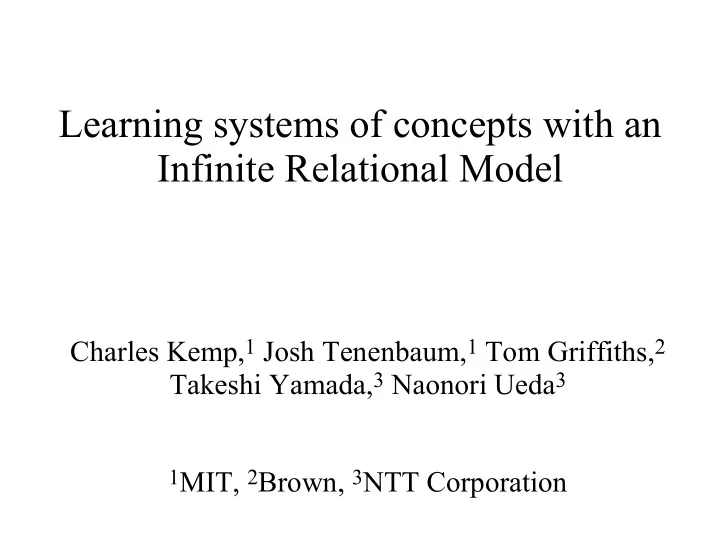

Learning systems of concepts with an Infinite Relational Model Charles Kemp, 1 Josh Tenenbaum, 1 Tom Griffiths, 2 Takeshi Yamada, 3 Naonori Ueda 3 1 MIT, 2 Brown, 3 NTT Corporation
Dominance relations at this conference Profs Grads UGrads Profs Grads UGrads
Predicate Invention a(1). a(6). a(4). r(1,8). r(1,3). r(1,5) ... b(8). b(2). b(3). b(5). c(9). c(7). r(X,Y) ← a(X),a(Y). (0.0) r(X,Y) ← a(X),b(Y). (0.9) r(X,Y) ← a(X),c(Y). (1.0) ...
Outline 1) Discovering concepts with an Infinite Relational Model (IRM) 2) Discovering the kind of relational system that best explains a data set Dominance Cliques Tree hierarchy
An Infinite Relational Model (IRM) 8 2 1 6 9 7 4 3 5 0.1 0.9 0.9 0.1 0.1 0.9 0.1 0.1 0.1 ● Goal: find z that maximizes
An Infinite Relational Model (IRM) ● Goal: find z that maximizes where is the number of 1-edges between classes a and b is the number of 0-edges between classes a and b is the Beta function where is the number of entities in class a
The IRM Input Output
Related Work ● Relational models – Sociology: ● Wang and Wong (1987); Nowicki and Snijders (2001) – Machine learning: ● Taskar, Segal and Koller (2001) ● Wolfe and Jensen (2004) ● Wang, Mohanty and McCallum (2005) ● Nonparametric Bayesian models ● Ferguson (1973); Neal (1991) ● Nonparametric Bayesian relational models ● Carbonetto, Kisynski, de Freitas and Poole (2005) ● Xu, Tresp, Yu, Kriegel (2006)
Clustering arbitrary relational systems ● 14 countries ● 54 binary relations representing interactions between countries (eg. exports to, protests against) ● 90 country features (Rummel, 1965)
Relation clusters (Rummel, 1965) 1. Brazil Netherlands 2. UK 1 2 USA 3 4 Burma 3. 5 Indonesia 1 2 3 4 5 Jordan Egypt 4. India Israel 5. China Cuba Poland USSR
Feature clusters (Rummel, 1965)
Towards Richer Representations a(1). a(6). a(4). r(1,8). r(1,3). r(1,5) ... b(8). b(2). b(3). b(5). c(9). c(7). r(X,Y) ← a(X),a(Y). (0.0) r(X,Y) ← a(X),b(Y). (0.9) r(X,Y) ← a(X),c(Y). (1.0) ... ● The concepts discovered by the IRM can serve as primitives in complex logical theories – cf. Craven and Slattery (2001); Popescul and Ungar (2004)
Outline 1) Discovering concepts with an Infinite Relational Model (IRM) 2) Discovering the kind of relational system that best explains a data set Dominance Cliques Tree hierarchy
Structural forms Dominance Partition Cliques Chain hierarchy Dominance Ring Tree tree
z 8 2 1 6 9 7 4 3 5 0.1 0.9 0.9 0.1 0.1 0.9 0.1 0.1 0.1
Dominance F Hierarchy 1 6 4 S 8 2 3 5 9 7 0.1 0.9 0.9 0.1 0.1 0.9 0.1 0.1 0.1
Dominance F Hierarchy 1 6 4 S 8 2 3 5 if S consistent 9 7 with z and F 0.1 0.9 0.9 0.1 0.1 0.9 0.1 0.1 0.1 ● Goal: find S that maximizes P(S|R,F)
F Ring 1 6 4 S 9 7 8 2 3 5 if S consistent with z and F 0.1 0.9 0.1 0.1 0.1 0.9 0.9 0.1 0.1 ● Goal: find S that maximizes P(S|R,F)
Learning structural forms Dominance F Hierarchy ● We place a uniform prior over the set 1 6 4 of forms and search for the S and F S 8 2 3 5 that maximize P(S,F|R) 9 7
Friendship groups (MacRae, Gagnon)
Bush Cabinet
Conclusions 1) The IRM discovers concepts (unary predicates) and relationships between these concepts. 2) An extended version of the IRM can discover abstract structural properties of a relational system.
Recommend
More recommend